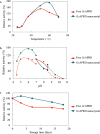Organic-inorganic nanocrystal reductase to promote green asymmetric synthesis
- PMID: 35516042
- PMCID: PMC9056328
- DOI: 10.1039/d0ra03160g
Organic-inorganic nanocrystal reductase to promote green asymmetric synthesis
Abstract
An acetophenone reductase from Geotrichum candidum (GcAPRD) was immobilized by the organic-inorganic nanocrystal method. The GcAPRD nanocrystal presented improved stability and recyclability compared with those of the free GcAPRD. Moreover, the GcAPRD nanocrystal reduced broad kinds of ketones with excellent enantioselectivities to produce beneficial chiral alcohols such as (S)-1-(3',4'-dichlorophenyl)ethanol with >99% yield and >99% ee. The robust and versatile properties of the GcAPRD nanocrystal demonstrated an approach to promote green asymmetric synthesis and sustainable chemistry.
This journal is © The Royal Society of Chemistry.
Conflict of interest statement
There are no conflicts to declare.
Figures





Similar articles
-
Substrate expansion of Geotrichum candidum alcohol dehydrogenase towards diaryl ketones by mutation.Appl Microbiol Biotechnol. 2024 Dec 27;108(1):545. doi: 10.1007/s00253-024-13375-0. Appl Microbiol Biotechnol. 2024. PMID: 39729095 Free PMC article.
-
Geotrichum candidum aldehyde dehydrogenase-inorganic nanocrystal with enhanced activity.Enzyme Microb Technol. 2021 Oct;150:109866. doi: 10.1016/j.enzmictec.2021.109866. Epub 2021 Jul 8. Enzyme Microb Technol. 2021. PMID: 34489025
-
Structural basis for a highly (S)-enantioselective reductase towards aliphatic ketones with only one carbon difference between side chain.Appl Microbiol Biotechnol. 2019 Dec;103(23-24):9543-9553. doi: 10.1007/s00253-019-10093-w. Epub 2019 Nov 15. Appl Microbiol Biotechnol. 2019. PMID: 31482280
-
Asymmetric autocatalysis and the origin of chiral homogeneity in organic compounds.Chem Rec. 2001;1(4):321-32. doi: 10.1002/tcr.1017. Chem Rec. 2001. PMID: 11893072 Review.
-
Band gap and composition engineering on a nanocrystal (BCEN) in solution.Acc Chem Res. 2010 Nov 16;43(11):1387-95. doi: 10.1021/ar100025m. Epub 2010 Aug 9. Acc Chem Res. 2010. PMID: 20695433 Review.
Cited by
-
Substrate expansion of Geotrichum candidum alcohol dehydrogenase towards diaryl ketones by mutation.Appl Microbiol Biotechnol. 2024 Dec 27;108(1):545. doi: 10.1007/s00253-024-13375-0. Appl Microbiol Biotechnol. 2024. PMID: 39729095 Free PMC article.
-
Immobilization of Thermoplasma acidophilum Glucose Dehydrogenase and Isocitrate Dehydrogenase Through Enzyme-Inorganic Hybrid Nanocrystal Formation.Curr Microbiol. 2024 Jan 18;81(2):67. doi: 10.1007/s00284-023-03577-6. Curr Microbiol. 2024. PMID: 38236425 Free PMC article.
References
-
- Nakamura K. Yamanaka R. Matsuda T. Harada T. Tetrahedron: Asymmetry. 2003;14:2659–2681. doi: 10.1016/S0957-4166(03)00526-3. - DOI
LinkOut - more resources
Full Text Sources
Miscellaneous

